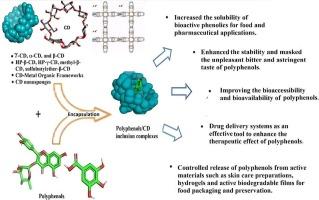Insights into polyphenols' encapsulation in cyclodextrins: An updated systematic literature review
IF 12.5
1区 化学
Q1 CHEMISTRY, APPLIED
引用次数: 0
Abstract
Polyphenols are phytochemicals derived from fruits, leaves, flowers, roots, and other parts of various plants and other natural resources. These secondary metabolites, with some currently could be chemically synthesized, are associated with a plethora of bioactivities, including anti-inflammatory, antimicrobial, antioxidant, hypolipidemic, and anti-diabetic activities. Recently, polyphenols have attracted a huge amount of attention in the food industry, as they are natural preservatives with some used as colorants and flavoring agents. However, the poor solubility and rapid degradation when exposed to environmental conditions, astringency and bitter taste, as well as the limited bioavailability of polyphenols hindered their applications in food products and pharmaceuticals. This work main objective is to provide an up-to-date overview of polyphenols' encapsulation in cyclodextrins (CDs) as reliable tools to overcome the aforementioned challenges. An overview of CD types, inclusion properties and the main techniques used to prepare and characterize inclusion complexes (ICs) will be provided. Interestingly, we systematically reviewed the current knowledge about CDs' encapsulation of phenolic acids, flavonoids, stilbenes, tannins, and other phenolic molecules. The use of CDs as encapsulation agents for chemically characterized phenolic-rich extracts will also be discussed. This review also covers bioavailability, various applications, limitations, and future perspectives on CD/polyphenol ICs.

多酚在环糊精中的包封:最新的系统文献综述
多酚是从果实、叶子、花、根以及各种植物的其他部分和其他自然资源中提取的植物化学物质。这些次生代谢物,其中一些目前可以化学合成,与大量的生物活性有关,包括抗炎、抗菌、抗氧化、降血脂和抗糖尿病活性。近年来,多酚类物质作为一种天然防腐剂在食品工业中引起了广泛的关注,一些多酚类物质还被用作着色剂和调味剂。然而,多酚的溶解度差,暴露于环境条件下降解迅速,涩味和苦味,以及有限的生物利用度阻碍了它们在食品和药品中的应用。这项工作的主要目的是提供一个最新的概述多酚包封在环糊精(cd)作为可靠的工具,以克服上述挑战。概述了包合物的种类、包合物的性质以及制备和表征包合物的主要技术。有趣的是,我们系统地回顾了目前关于CDs包封酚酸、类黄酮、二苯乙烯、单宁和其他酚类分子的知识。本文还将讨论用CDs作为包封剂包封富酚提取物的化学性质。综述了CD/多酚集成电路的生物利用度、各种应用、局限性和未来展望。
本文章由计算机程序翻译,如有差异,请以英文原文为准。
求助全文
约1分钟内获得全文
求助全文
来源期刊

Carbohydrate Polymers
化学-高分子科学
CiteScore
22.40
自引率
8.00%
发文量
1286
审稿时长
47 days
期刊介绍:
Carbohydrate Polymers stands as a prominent journal in the glycoscience field, dedicated to exploring and harnessing the potential of polysaccharides with applications spanning bioenergy, bioplastics, biomaterials, biorefining, chemistry, drug delivery, food, health, nanotechnology, packaging, paper, pharmaceuticals, medicine, oil recovery, textiles, tissue engineering, wood, and various aspects of glycoscience.
The journal emphasizes the central role of well-characterized carbohydrate polymers, highlighting their significance as the primary focus rather than a peripheral topic. Each paper must prominently feature at least one named carbohydrate polymer, evident in both citation and title, with a commitment to innovative research that advances scientific knowledge.
 求助内容:
求助内容: 应助结果提醒方式:
应助结果提醒方式:


